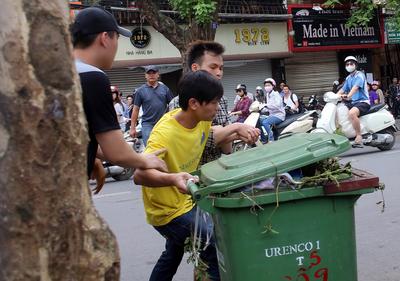Some opined that Chinese agents were behind the riots, while others guessed that it was provocateurs deployed by the regime. Some speculated further still that the upheaval was orchestrated by cadres of the banned Viet Tan Party. Yet, after a week of debate, Vietnam’s bloggers and pundits failed to identify an unseen mover. Though some local police headquarters claimed to have found evidence that a core group of rioters received cash and instruction, clearly for the great majority of participants the riots were an unscripted and spontaneous event.
Commentators unearthed various reasons why tens of thousands of blue-collar Vietnamese men might run amok. To a small degree, the mobs were angered by China’s deployment of a deepwater oil drilling rig into waters claimed by Vietnam. To a far greater degree, and probably without much forethought, the crowds saw and seized an opportunity to vent frustration over the conditions that prevail in and around Vietnam’s industrial zones, particularly in Chinese, Taiwanese and Korean-owned enterprises.
In the industrial zones, the hours are long and the pay is low. Assembly work involves intricate, repetitive tasks that must be performed quickly and accurately. The workers are often young people from rural areas who have migrated to the cities in the hope of sending money home to their parents or perhaps putting a bit aside for future financial security.
Vietnamese newspapers often feature stories about the hard life factory workers face. Though the papers do not cover wildcat strikes as aggressively (the Ministry of Information discourages it), government data showed a substantial uptick in unsanctioned stoppages in the export processing sector in 2010 and 2011, as inflation drove down workers’ real wages. In August 2012, the minimum wage was raised to US$95 per month.
Very few if any of the young men who rampaged at factories in Bien Duong and Bien Hoa, industrial suburbs of Ho Chi Minh City, were factory hands. At Vung Ang in Ha Tinh province, where the Taiwan-based conglomerate Formosa Plastics is building a giant steel mill, press reports suggest that the Vietnamese rioters were construction workers employed on the same site as hundreds of immigrant Chinese workers and foremen.
Photos of the crowds suggest that most of the rioters were semi-skilled labourers, also from rural areas. When they are lucky, these urban migrants find work on construction projects or delivering small consignments of goods. Some drift into the underworld, becoming thugs for hire who can be used to break up strikes or persuade farmers to part with land coveted by developers. When out of work, they’re easy recruits for a flash mob, especially as nearly all of them would have a mobile phone and a motorbike.
The authorities rounded up hundreds of the rioters in the days that followed, and said that at least half could be prosecuted. And that’s about all the authorities have said. How the rioters coalesced remains a mystery. The leaders have yet to be identified. In the event, a demonstration against the ‘Chinese’ — symbolised by factory owners, managers, foremen and migrant workers — morphed into a day of rioting, violence and, inevitably, looting. When police were slow to react, both in the suburbs surrounding Ho Chi Minh City and a day later in Vung Ang, the mobs swelled to a size the police were powerless to control.
Embarrassed, Hanoi hastened to reassure foreign investors that the industrial zone riots were a one-time thing. The fact is, however, that the riots differed only in scope and scale from the strikes and protests that have been erupting in recent years at many hundreds of worksites and foreign-owned factories.
David Brown is a former US diplomat who has worked in Vietnam for many years.

